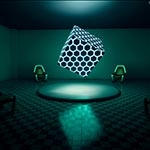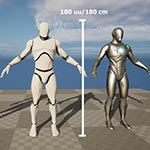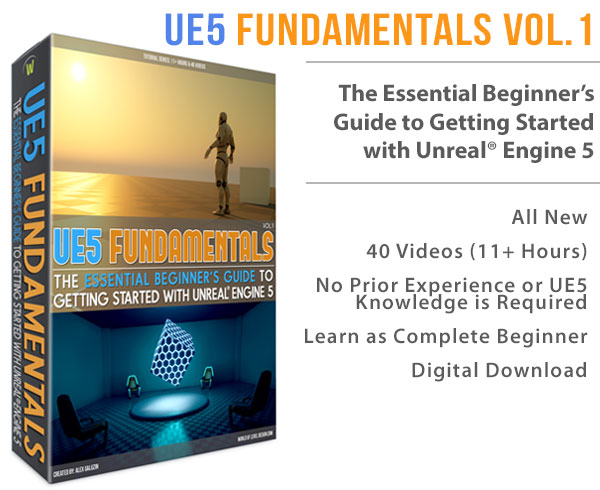World of Level Design™
Tutorials to Becoming the Best Level Designer and Game Environment Artist (since 2008)
UE4: In-Depth Level Creation Workflow - From BSP to Final Level/Environment
Category: UE4
October 15, 2019

I love BSP!
I love creating with it, I love using it but there are a lot of missing steps between BSP and final level.
How does BSP fit into the larger context of a completed game environment?
BSP was used as beginning blockout and final geometry in older game engines such as original Unreal Engine, Quake Engine, Gold Source and Source Engine. But with UE4 this is no longer the case.
"So I get to use the BSP brushes to blockout my level. But what do I do next? How does it all come together in the end from BSP blockout to final level?"

During Blocktober you see a lot of work that show before and after - the BSP blockout and the final environment.
It reminds me of how to drawn an owl:
- Draw some circles
- Draw the rest of the owl

Same idea creating levels:
- Use BSP to blockout
- Create the rest of the environment

BSP Blockout from "UE4: The Corridor Project"

Final level from "UE4: The Corridor Project"
What are the steps in-between? How do you get from BSP blockout to the final level?
In this tutorial you'll know the answer.
Let's go deeper into level creation workflow, from BSP blockout to final environment and ALL the steps in-between.
Video Tutorial
Standard Level Creation Workflow
Let me show you the standard, 4-step level creation workflow to get you started.
In the Content Examples project which can be found in UE4 Marketplace, you'll find a map called LevelWorkflow:

This map shows you a 4-step workflow from beginning to end.
Standard 4-Step Level Workflow
- Prototype Pass: use basic BSP geometry or Static Mesh Actors (not pretty but playable)
- Meshing Pass: use finished (or close to finished) assets; still simple lighting
- Lighting Pass: place lights, adjust Post Process, adjust Materials
- Polish Pass: add effects, reflection actors, blocking volumes, audio and final detail

Standard level creation workflow
This is a good start but it groups too many steps in the lighting and polish pass. Let me give you an expanded workflow to use instead.
Expanded 6-Step Workflow for Level Design and Game Environments
- Blockout/Prototype Pass
- Gameplay Pass
- Meshing Pass
- Lighting Pass
- Post Process and Effects Pass (each can be a separate steps)
- Polish Pass
Let's cover each step in-detail.
Step 1: Blockout/Prototype Pass
First step in the process is the BSP blockout. You use BSP brushes and begin building the playable level or stand-alone game environment.

BSP blockout
During BSP blockout you focus on layout, floor plan and spatial relationships, establishing size, scale, dimensions and correct proportion of the environment.
It won't look pretty but it should be playable.
Remember, you are creating the framework onto which the entire environment will be built.
Step 2: Gameplay Pass
Second step is crucial if you are creating a playable level.
Gameplay pass is focused on integrating gameplay mechanics, scripting the logic, setting up objectives, missions, level's flow, pacing and lots of playtesting.

Gameplay pass
If you're creating a stand-alone game environment (non-playable level), then you can skip the gameplay step.
Use MIT Acronym
During the first two steps, I keep this acronym in mind as I work - MIT.
What does MIT stand for?
Modify, iterate and test.
MIT = Modify, Iterate, Test
As you blockout and playtest - always be modifying, iterating and testing.
Most of the big changes happen during blockout and gameplay steps.
You will still modify, iterate and test throughout the entire production pipeline but in the later stages it becomes more about tweaking, optimizing and polishing.
So remember to modify, iterate and test a lot during blockout and gameplay passes as you narrow down the gameplay mechanics and environment's vision.
Step 3: Meshing Pass
In UE4, you rarely see BSP brushes in the final level. So what happens to BSP brushes after the blockout?
All BSP brushes get replaced with Static Meshes.
What are Static Meshes?
Static Meshes are 3d models that are created inside 3d modeling software (Maya LT/Maya, 3ds Max, Blender, Modo etc).
Static Meshes are more performance efficient than BSP brushes can ever be. Remember that BSP brushes were never intended as final in-game geometry in UE4. They are only there to be used for creating the framework of the level. But eventually BSP will be replaced with Static Meshes.
During Meshing Pass you replace BSP brushes with Static Meshes, making the environment pretty.

Static Meshing
The goal is to have 100% Static Meshes in your final level but you can have some BSP brushes. Although you want to keep these brushes simple and down to a minimum.
Most of Static Meshes should be finished (or close to finished) assets. They will be the final geometry that will ship with your level.
You can learn the entire process of how to create your own custom Static Meshes for UE4 in this course.
Step 4: Lighting Pass
Up to this point you should be using simple lighting to help you see the scene. But now during Lighting Pass you must focus entirely on lighting the environment.

Lighting pass
As you begin lighting, make sure to collect sufficient lighting reference to know what you want your scene to be lit like.
The environments in UE4 can be lit using dynamic lighting, static lighting or both.
Start with primary light source, then secondary light sources then detail and fill-in lights.
The primary light source is the sun or moon (Directional Light) and the ambient lighting from the sky (Sky Light).
Secondary light sources are artificial lights such as lamps, fire, monitors, tv, candles etc.
Lighting has two components you'll have to deal with - artistic and technical. So lighting may take some time to get right.
Step 5: Post Process and Effects Pass
In the Standard Level Workflow, Post Process is combined together with lighting.
It's true, you shouldn't view lighting and Post Process as separate steps because they affect each other.
BUT,
I separate working on lighting and Post Process as their own steps.
Post Process is a visual filter for how the environment will look like. Think of it as adjusting a photo - making it sharper, brighter, controlling highlights, mid-tones, shadows, adding vibrancy and saturation to the scene.
You can find the Post Process settings by inserting a Post Process Volume:

Then adjusting Post Process settings:

Step 6: Polish Pass
Polish Pass is where the final scene comes together.

Final polish pass
You add blocking volumes to prevent players from entering certain areas (if it's a playable environment). You add audio. You do a lot of testing and fixing of bugs that pop up.
The polish pass is the final detail pass.
PS.
To summarize here is the overview from BSP to final level workflow:
- Blockout/Prototype Pass: blockout the level with BSP brushes - focusing on layout, floor plans and spatial relationships (size, scale, dimensions)
- Gameplay Pass: playtest gameplay and flow (game mechanics, scripting)
- Modify, iterate and test
- Meshing Pass: add Static Meshes, replacing BSP brushes with Static Meshes - making it pretty (working on the art of the level)
- Lighting Pass: add, adjust and tweak lighting and post process
- Post Process and Effects Pass: add, adjust and tweak lighting and post process
- Polish Pass: add effects, reflection actors, blocking volumes, audio, particle effects and final detail
Next Tutorial
UE4: What are the Advantages and Disadvantages of Using BSP?
Home Terms of Use/Trademarks/Disclaimers Privacy Policy Donate About Contact
All content on this website is copyrighted ©2008-2024 World of Level Design LLC. All rights reserved.
Duplication and distribution is illegal and strictly prohibited.
World of Level Design LLC is an independent company. World of Level Design website, its tutorials and products are not endorsed, sponsored or approved by any mentioned companies on this website in any way. All content is based on my own personal experimentation, experience and opinion. World of Level Design™ and 11 Day Level Design™ are trademarks of AlexG.
Template powered by w3.css


 UE5: How to Download and Install Unreal Engine 5 in 5 Minutes
UE5: How to Download and Install Unreal Engine 5 in 5 Minutes UE5: 11 Principles to Learning and Using UE5 as a Complete Beginner
UE5: 11 Principles to Learning and Using UE5 as a Complete Beginner UE5: Crash Course Quick-Start Guide to Begin Using UE5 - TODAY
UE5: Crash Course Quick-Start Guide to Begin Using UE5 - TODAY UE5: Complete Guide to Player Scale, Dimensions and Proportions
UE5: Complete Guide to Player Scale, Dimensions and Proportions UE5: Fundamentals Vol.1 - Essential Beginner's Guide to Getting Started
UE5: Fundamentals Vol.1 - Essential Beginner's Guide to Getting Started


